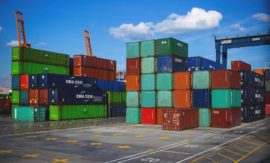Intended learning outcomes: Describe the reasons for logistics networks, production networks, procurement networks, distribution networks, and service networks. Produce an overview on the supply chain, the extended enterprise and supply chain management.
For products of a certain complexity, design and manufacturing are often distributed among several companies or among different organizational units within a company. From the perspective of the individual manufacturer, the reasons for this are, for example:
- Quality: Some technologies or processes may not be mastered successfully enough (problem of effectiveness, that is, achieving the given or expected quality standard).
- Costs: Certain technologies or processes cannot be implemented economically (problem of efficiency, that is, the actual output compared with the output expected, with regard to the use of means).
- Delivery: Some processes are not rapid enough, or they are unstable over time.
- Flexibility: Customer demand may show rapid variation; the company’s own competencies or capacity cannot be adapted quickly enough.
A logistics network is the joining of the logistics of several organizational units, that is, companies or parts of companies, to form comprehensive logistics.
Production network, or production system, and procurement network can be used as synonyms of logistics network.
The end user of a logistics network is the consumer.
Figure 1.1.7.1 shows an example where three organizational units form a logistics network. Here it is a logistics chain.
Fig. 1.1.7.1 Three organizational units in a logistics chain.
The logistics chain between two stores is crucial. The logistics of the second organizational unit in Figure 1.1.7.1 must not be viewed in isolation. The logistics of the first organizational unit and the logistics of the third organizational unit will have a direct influence on the logistics of the second organizational unit, since there is no buffer between the two stores.
From the perspective of the end user, distribution and service networks also belong to value-added, for only with delivery and possibly service is the customer order fulfilled.
A distribution network, or distribution system, is a group of interrelated facilities — manufacturing and one or more levels of warehousing — linking the production, storage, and consumption activities for spare parts and finished goods inventory [ASCM22].
A service network is a group of interrelated facilities for performing all services in connection with material or nonmaterial goods.
This leads to the following general terms used for all the types of networks mentioned above (i.e. in the previous subsection):
A supply chain is the global network used to deliver products and services from raw materials to end customers through an engineered flow of information, physical goods, and cash [ASCM22]. A comprehensive definition of supply chain also includes the networks for disposal and recycling.
The extended enterprise is the notion that supply chain partners form a larger entity. These partners form the supply chain community (cf. [ASCM22]).
Supply chain management (SCM) is the design, planning, execution, control, and monitoring of supply chain activities with the objective of creating net value, building a competitive infrastructure, leveraging worldwide logistics, synchronizing supply with demand, and measuring performance globally ([ASCM22]).
Course section 1.1: Subsections and their intended learning outcomes

1.1 Basic Definitions, Issues, and Challenges
Intended learning outcomes: Produce an overview on terms of the working environment and of business life. Explain service orientation in the classical industry, product orientation in the service industry, and the industrial product-service system. Disclose the product life cycle, the synchronization of supply and demand, and the role of inventories. Produce an overview on supply chain management, the role of planning and control as well as the SCOR model.

1.1.1 Work, Task, Process, Method, Object, etc. — Important Terms of the Working Environment
Intended learning outcomes: Produce an overview on terms of the working environment, such as work, task, function, order, procedure, process, method, object, business.

1.1.1b Value-Added, Business Process, Material, Product, etc. — Important Terms of Business Life
Intended learning outcomes: Produce an overview on terms of business life, such as value-added, business process, business method, business object, goods, item, part, component, material, product, artifact, management, etc.

1.1.2 Service and Servitization — Service Orientation in the Classical Industry
Intended learning outcomes: Present terms of the service domain such as service, customer service, service in the originary sense, servitization. Differentiate between a (primary, or core) product, a product in a broad sense, and a product in the most comprehensive sense.

1.1.3 The Service Industry and Industrialization of Service — Product Orientation in the Service Industry
Intended learning outcomes: Differentiate between service industry and classical (or conventional) industry. Produce an overview on industrialization of service.

1.1.4 The Industrial Product-Service System IPSS (or IPS2)
Intended learning outcomes: Present the industrial product-service system. Explain product-oriented, use-oriented, and result-oriented services as well as their degree of intangibility.

1.1.5 The Product Life Cycle: Design and Manufacturing, Service and Use, Recycling and Disposal
Intended learning outcomes: Differentiate between terms such as logistics, operations, logistic management, operations management, and value-added management.

1.1.5b Logistics, Operations, Logistics Management, Operations Management, and Value-Added Management
Intended learning outcomes: Differentiate between terms such as logistics, operations, logistic management, operations management, and value-added management.

1.1.6 The Customer Tolerance Time (or Demand Lead Time), and the Role of Inventories
Intended learning outcomes: Describe supply, demand, lead time, and customer tolerance time. Explain the problem of temporal synchronization between supply and demand as well as the role of various kinds of inventories in solving this problem.

1.1.7 Supply Chain, Extended Enterprise, and Supply Chain Management
Intended learning outcomes: Describe the reasons for logistics networks, production networks, procurement networks, distribution networks, and service networks. Produce an overview on the supply chain, the extended enterprise and supply chain management.

1.1.8 Circular Economy and Integral Logistics Management
Intended learning outcomes: Present circular economy and integral logistics management.

1.1.9 Supply Chain Planning and the Planning & Control System
Intended learning outcomes: Produce an overview on supply chain planning. Differentiate between production planning and control (PPC) and a PPC system.
